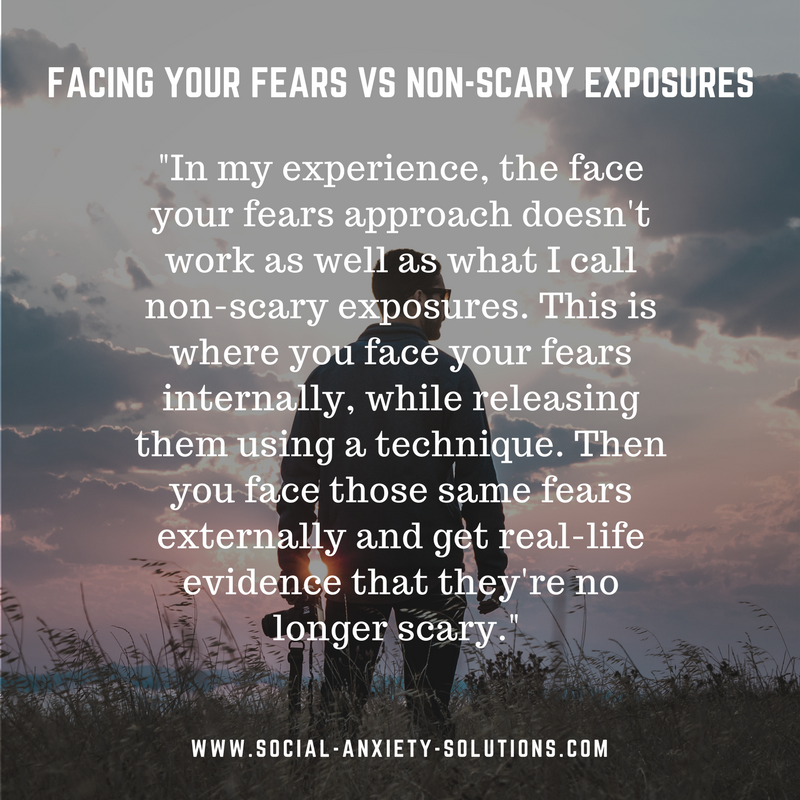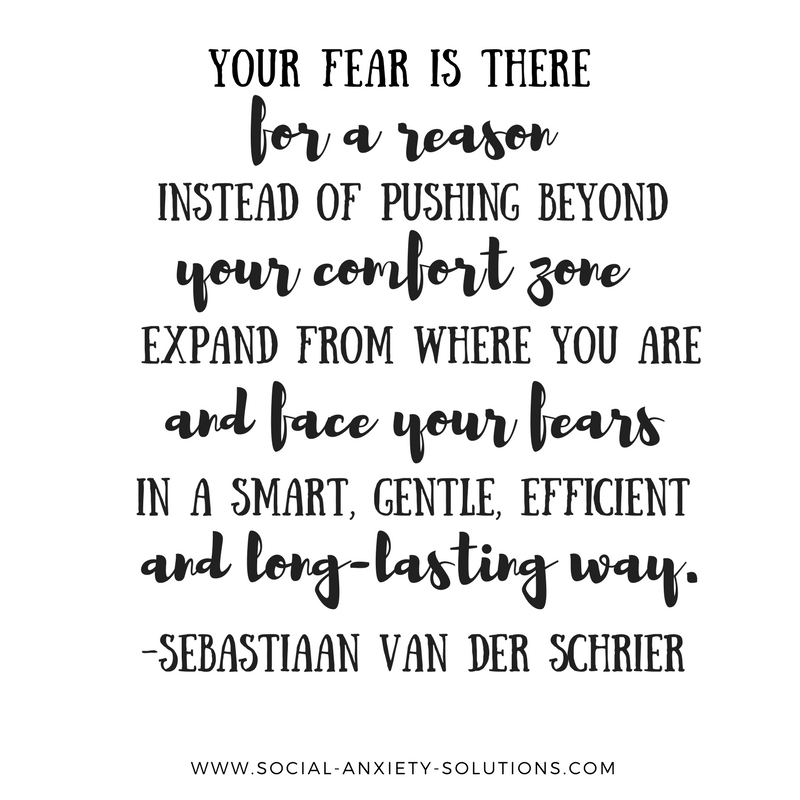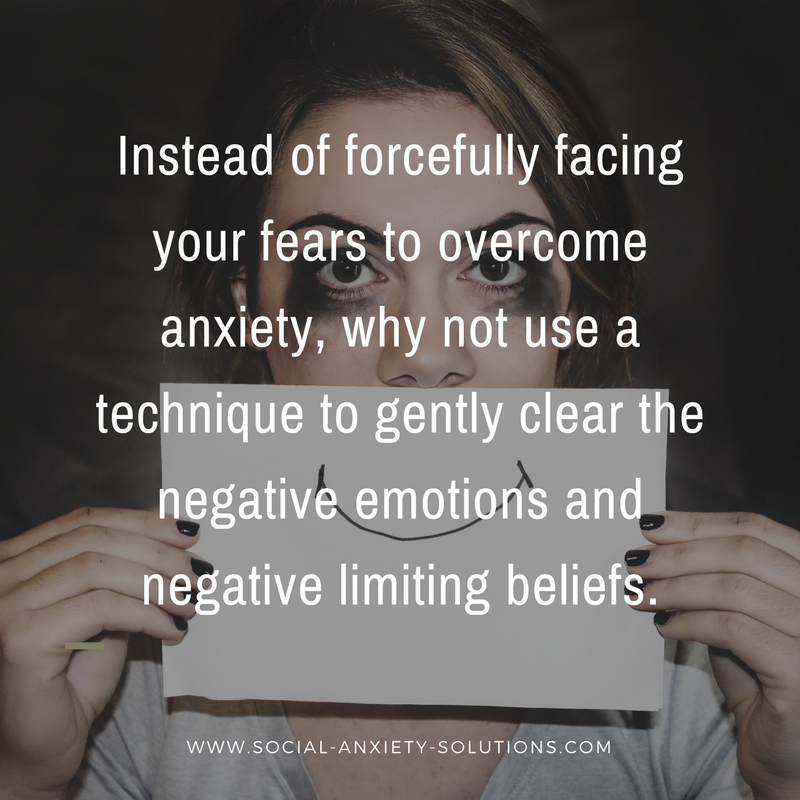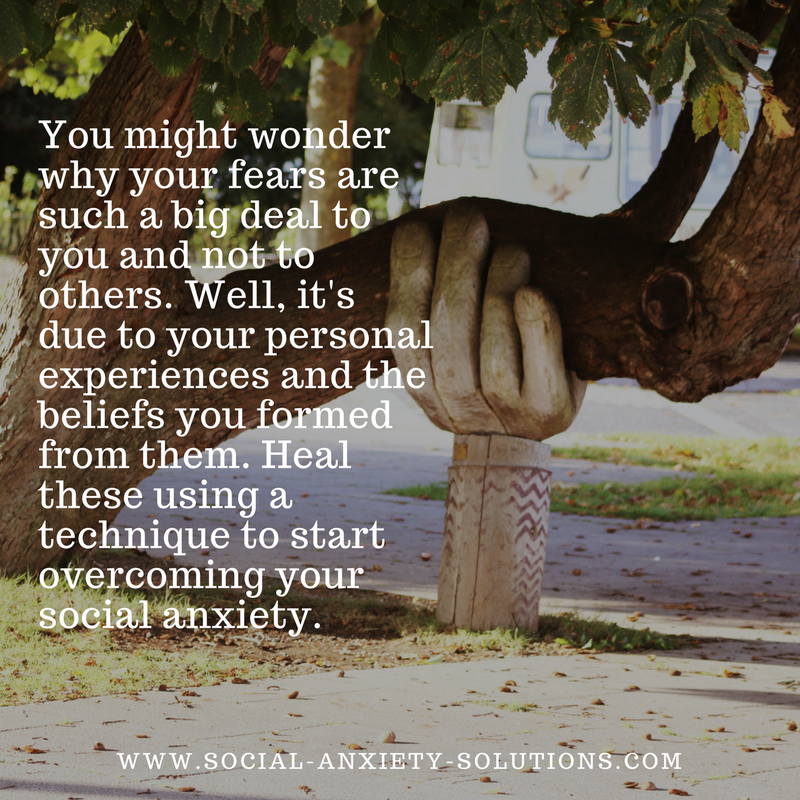SUMMARY
In this post, we offer some relief from feeling you have to push yourself to forcefully face your fears…
… we’ll give you a fresh new approach to overcoming your social anxiety.
Here are some things you’ll learn:
- The face your fears approach to overcoming social anxiety (and how it didn’t work for me)
- Benefits of using non-scary exposures to overcome your social anxiety
- A way to expand your comfort zone versus pushing yourself too far (and getting faster results)
This may be a different approach than you are used to, but in my experience it brings real healing and real results.
This approach is aimed at the real source of the problem without painfully exposing yourself to your fears in the real world.




FULL TRANSCRIPTION
Sebastiaan: Hey, this is a Sebastiaan from socialanxietysolutions.com. I’m a social confidence coach and I help people with social anxiety feel calm and relaxed in social situations. And today I wanted to talk a little bit about how to face your fears in a way that is… Shall I say smarter, more gentle, easier, better results. However, you want to say.
“Facing your fears” approach
So, there is your basic approach of “facing your fears” which is basically you make a hierarchy of the things that you are afraid of and you list them, well, this is the thing I’m most afraid of and I’m less afraid of this one, I’m less afraid of this one and then you face your least scary fear and then you gain some confidence from that and you go for the next one.
That’s the idea in cognitive behavioral therapy. I’m not a cognitive behavioral therapist but that that’s the basic approach from my limited understanding. And you know, in my experience that doesn’t work as well as the following. So, I call it non-scary exposures because they’re actually not scary. So, let me turn around. There we go. And a cool thing is that they… you face your fears, but you face your fears internally first and then once you’ve released the fear, once you’ve letten them go. Letten, that’s a new English word. Once you’ve let go of the fear of the thing that you are afraid of and you no longer have the fear then you face the thing that you used to be afraid of without fear and get some real-life evidence that that which you were afraid of is actually not that scary. And that builds you know, positive resource experiences in your brain and does a lot of good.
So, let me give you an example. So, there is “Force yourself to face your fears”, which is the old approach and there is non-scary exposure which is the new approach. So, the old approach, I’ll give you an example of something that I did in the past. All right, well, there are a bunch and just thinking about, which is a nice story. All right, so, I was really afraid of embarrassing myself and so I was told if you just you know, push yourself to do the thing that you’re afraid of most which is embarrassing yourself then you can become immune to that fear. Just push through the fear, do it, right? So, I psyched myself up for weeks planned the whole thing out. I was scared many, many weeks in advance and then as the date came nearer that I was gonna do this scary thing where I was really gonna push myself to do that, that difficulty sleeping the days before. But then you know, it’s game time and I pushed myself and I listened to all the motivational tapes and I’m really gonna do it.
And so, I did. I went out, I bought the brightest red lipstick, smeared it over my lips, circled it around my eyes. This was actually in Kuala Lumpur, Malaysia. And then I went on the street and busy, busy shopping street, starting conversations with people, “Hey, how’s it going?” People be like “What’s up with your face? What’s wrong with you?” And I pretend like nothing was going on because that was part of the exercise. And in the beginning was extremely awkward but soon enough I kind of got used to it and it was not a big problem anymore. You know, after maybe half an hour, 45 minutes, there you go. And then I became more comfortable with it and then at the end after about an hour or so, I’m like “Huh, I don’t care so much anymore what people were thinking of me. This is great.” And then I had this confidence but then if you’re familiar with my work or if you’ve done this yourself you might have experienced the same. The confidence that you so painfully gained kind of… you kind of lose it again and then you’re back to square one. So, that didn’t really work.
So, that’s the old approach or that’s at least one of the… you know, one of the things that you could do. It’s kind of this is not building hierarchy, this is more like flooding. They call it where you do the thing that you’re really this scared, the most scared of. It’s kind of like comes from these motivational quotes like Nike – “Just do it”, you know, and “Feel the fear and do it anyway”, and you know, “The death of fear is certain after you’ve faced it”, and “There’s only one way out of the fear and that’s through it”. And all these you know, motivational quotes and these are all true to a degree but it’s really scary, takes a lot out of you, doesn’t always work that much, that well.
What is a non-scary exposure?
So, what is a non-scary exposure? Well, non-scary exposure is this. So, when I work with a client and a client has a huge fear of embarrassment, I wouldn’t tell him to do what I did. Instead, I look at, “Alright, what are you so afraid of?” Like, “Oh, well, embarrassment”. Well, why is it that you… I need to sit down. Why is it that you’re so afraid of embarrassment? Why is it such a big deal to you and why is it not to other people? Why is that the case? And you know, I’d be asking him some questions, we’ll do some exercises and eventually we might find out that when he was 15 and in school he was bullied for two years and he was embarrassed there often.
Alright. Well, there’s a clue. He’s had embarrassing experiences that were very painful, there he learned, his brain learned that it’s a really big deal to be embarrassed. He lost it, he lost his self-acceptance, if that over already was in place before that, and so, there is basically, I’m looking for “What is the reason that that fear is so intense?”
Well, the reason for that is traumatic experiences and the beliefs learned from those experiences.
Clearing the negative emotions
So, what we then do is we go back there, and we clean that up. So, we release the excessive negative emotions that have gotten stuck in his system and we use a variety of techniques for that. One of them is tapping EFT – Emotional Freedom Techniques. Tapping, basically, if you don’t know what it is, is psychological form of acupuncture. You know, as stuff with the needles, but instead of the needles, you tap with the tips your fingers at specific acupressure points in the body. It looks really weird, looks bizarre but it is amazing. It’s used by millions of people worldwide. It’s been on Oprah Network, Psychology Today, Dr. Oz, you know, you name it. Scientifically proven to be effective.
Anyway, look it up. If you don’t know what it is or check out some of my other videos. That’s one of the techniques we use. However, so, basically what I’m doing with this client is I’m looking for, “Alright, why is he so afraid of this embarrassment?” Well, because of these experiences in the past and the beliefs that he learned from that.
The emotions there are still active to his brain though those memories are not processed. They’re still in procedural memory active memory and when he is in situations where he might become, where he risks embarrassment, anxiety is there to tell him, “Hey, careful. You know, remember between age 15 and 16 all those times you could bullied this is a situation where that might happen all over again. So, careful.”
And what we’re doing is we’re erasing… It’s not the right word, we’re neutralizing those experiences, we’re getting rid of the emotions from those experiences that are still stuck there, so, that he can no longer relive the feelings that he had when he was 15 or 16 years old.
Clearing the negative limiting beliefs
And we also get rid of the lessons learned there. The negative learnings, the limiting beliefs that were picked up at that time. And so, then the brain no longer uses those experiences age 15-16 as a resource for to predict what’s going to happen into here and now. And the memories that were held in procedural memory, active memory then get play, they get dumped in the box of no longer relevant memories because the emotion is what keeps them relevant. And so, the emotion goes out of it and it just goes into the box of you know, what do you eight, three weeks ago on a Tuesday, unless it was special time you don’t remember at or it’s not relevant to you anymore. It’s like that.
So, it goes out of procedural memory and then it doesn’t bother you anymore. So, then with my client at the start of a session, he might have a fear of embarrassment that it’s like eight out of ten strong and so, really big fear when he thinks about it. And we go back to where he basically learned to fear becoming embarrassed. We get rid of the learning and then as we’ve erased that, as we’ve neutralized that. I might say, “All right, well, how do you feel now when you think about that situation where you were where you feared becoming embarrassed?” And you might say, “Well, I’m calm about it. It’s strange but it doesn’t bother me right now. I don’t feel upset about it.” And then, great
Then I might say, “All right, well, go out and face your fear”. And as I say that maybe there are some things that we haven’t covered yet. Maybe he has some worries, maybe he has some negative expectations, maybe he has some concerns and we then look at that, we just do some tapping on that, we reframe that until he can get to a point where he anticipates the future situation that he used to be afraid of and he can think about it feeling calm, having positive expectations.
The result is a positive, permanent approach
And then when he actually goes and does the thing, now he’s comfortable, you go through it, maybe he gets a little spike up, but there’s no nowhere near what it used to be if he actually pushes through his fear. And he’ll find most likely that he’ll be relatively calm going through the experience. You know, likely has it have a good experience and they don’t feel calm at the end of it and you all have a positive resource experiences, experience that also goes counter to what I used to think.
And now the brain will use that as a resource for predicting how things are going to be in the future.
So, that’s a non-scary exposure because you know, the thing that you’re exposing yourself to is no longer scary. So, that’s the latest you know, and that’s a really real cool way to face your fear. So, you know, I did this myself just last week. I’m living here in Bali and you have all these odd and weird workshops here and there was an intimacy workshop while I don’t have social anxiety. This is something that I’m like, “Okay, well, I’m not sure if I’m too comfortable about that”. So, I just looked beforehand, “All right, do I have any fear about attending a workshop like that? No, I’m not really but I have some negative expectations. All right, so, let me look at that. What am I you know, what am I worried about?” You know, I wrote down one or two worries, I did some tapping on it, reframed it and just you know, came up with some reasons why I wanted to do it. Well, so, I can connect better with people, so I can go deeper in my relationships, so I have a new experience, so I have something to talk about on video. You know, and so, that I challenged my comfort zone, you know, so I can expand my comfort zone and become comfortable with it.
So, anyway, so, I did that, had positive expectations, went over there, was very interesting, there were indeed definitely exercise I had never done before, started out with walking around in a room with 40 people, making eye contact with someone and then you know, eye gazing for a couple of minutes. There was like sitting back to back and synchronizing each other’s synchronizing your breathing, there was giving a hand massage and giving instructions. All sorts of things to see, “Hey, do I have some discomfort here? And if so, great. You know, because I’m gonna use that afterwards after the workshop. I’ll sit down, and I’ll do some tapping on the discomfort that I have uncovered.”
So, in this way you actually face your fears and if then something comes up for you, you’re like, “Great, now I can address this, and I’ll be more comfortable next time which is fantastic”. So, facing your fears no longer is just something I’ve got to grit my teeth and push out myself through it and afterwards finally you know, I survived, now I need to recover for a while. Now you actually go through it. With positive expectations you get a great experience. I felt great afterwards, this was one thing I was a bit uncomfortable with and that was you know, giving a compliment, not very, very used to that. Probably a bit with my upbringing my culture. The Dutch are not very complimentary people.
And yeah, so, I just looked at that afterwards and I made some more inner growth, I expanded my comfort zone. This is not pushing yourself beyond your comfort zone, this is expanding your comfort zone by doing the inner work to be stronger to get rid of the fear because the fear is there for a reason – The learning experience that you had, the painful experience that you had in the past. You address that, and you get rid of it, you expand your comfort zone, you go through the experience, you have positive resource memories now that your brain is going to use to predict future experiences and everything is just a lot easier. So, this is a way to face your fears in a smarter, more gentle, more efficient long-lasting you name it way.
So, I hope this has been helpful. If you have any comments about this, feel free to put them on there here. If you want more videos like this, every Thursday I create one, hit the subscribe button here or here or wherever it is placed, and you know, check out my channel. I’ve been making videos for a long time. You can see video testimonials of people that I’ve helped overcome their social anxiety completely. Some in as little as 3 coaching sessions, some I worked with for a longer period of time. You’ll find these video testimonials on my channel.
And I have a podcast where I interview Western traditionally trained psychologists who have incorporated energy psychology into their practice and I’ve seen the results with their clients go through the roof. People that wouldn’t be able to get results and now get results, people that normally take years, now only take months or even weeks. It’s amazing.
I have PhD researchers that I interview, best-selling authors, doctors, therapists, coaches, psychotherapists, you name it. So, that’s the Social Anxiety Solutions podcast which you can find in iTunes or on my channel.
And I mentioned the EFT technique, I have a free social confidence starter kit where I actually teach you the technique for free over a series of videos and I guide you through an experience of it. You can check that out by going to the link below this video and there I also have my eBook where I teach you how you can become completely free of social anxiety, calm and relaxed at social situations using that technique.
Alright, that’s enough talking for me. I’m gonna go to the cinema with a couple of friends. Hope this has been helpful. Leave a comment below and I will talk to you next week. Bye for now.
If you experience Social Anxiety, click below to receive the FREE “7 Secrets to Social Confidence” Mini Course!
- How To Stop Worrying - January 17, 2024
- How to Reduce Facial Blushing with EFT Tapping? - June 29, 2023
- Are You Scared to Get Anxious? Here’s how to fix it! - June 16, 2023


